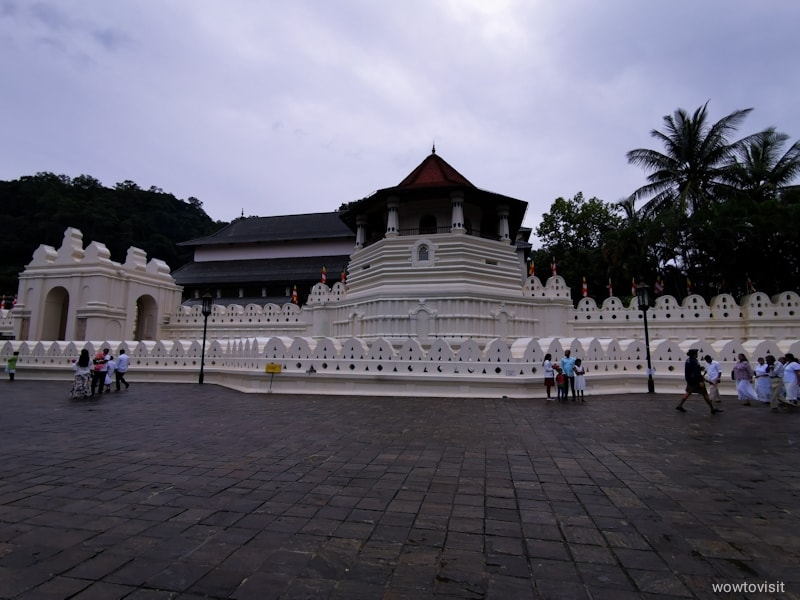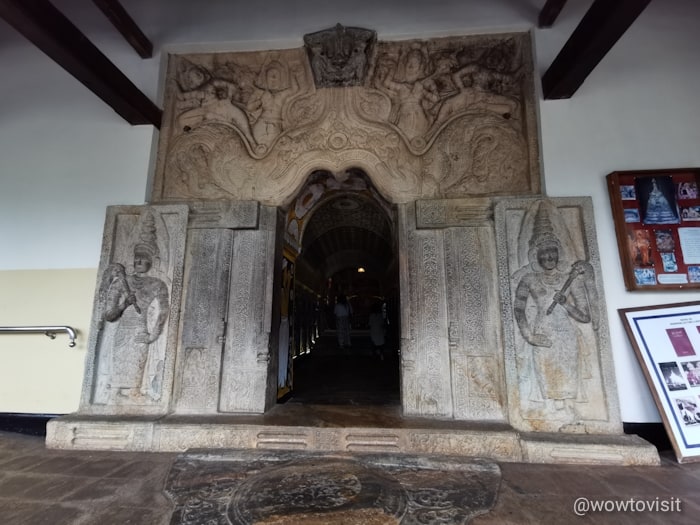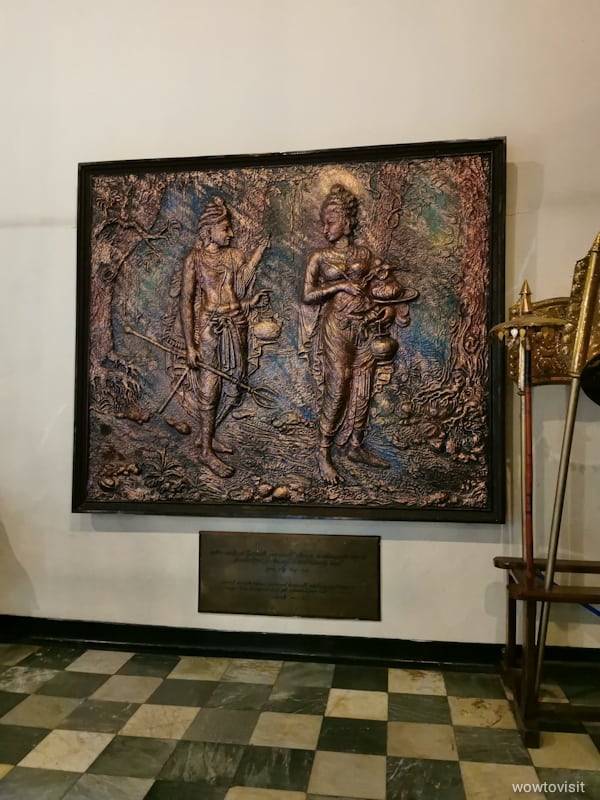If you are a history buff, culture enthusiast, or just an admirer of breathtaking architecture, then Sri Dalada Maligawa, or the Temple of Tooth Relic, is a must-visit destination in Sri Lanka. Situated in the hill city of Kandy, this temple is one of the most sacred places of worship for Buddhists around the world.
Exploring the Rich History of the Temple of the Sacred Tooth Relic
The history of the Temple of the Sacred Tooth Relic can be traced back to the 4th century BC when the tooth relic was brought to Sri Lanka by the Indian Princess Hemamala and her husband Prince Dantha. They brought the tooth relic with them to keep it safe from the invading armies of India.
The tooth relic was then enshrined in the city of Anuradhapura, which was the capital of Sri Lanka at that time. However, due to repeated invasions, the tooth relic was moved from one location to another until it finally found its resting place in Kandy in the 16th century.
The Temple of the Sacred Tooth Relic was built by King Vimaladharmasuriya I in the 17th century, and it became the most important place of worship among Buddhists in Sri Lanka. Over the years, the temple has undergone several renovations and additions, making it one of the most impressive architectural feats of Sri Lanka.
The Tooth Relic:Sacred Symbol of Buddhism
The Sacred Tooth Relic is the most treasured possession of the Temple of the Sacred Tooth Relic. The relic is believed to be the left canine tooth of the Buddha, which was recovered from his funeral pyre in India in the 5th century BC.
The tooth relic has a fascinating history, and many legends and myths surround it. According to one legend, the tooth relic was smuggled into Sri Lanka hidden in the hair of Princess Hemamala, and it remained hidden for centuries until it was discovered by King Vimaladharmasuriya I.
The tooth relic is kept in a golden casket, which is then placed inside several other caskets made of silver, gold, and other precious materials. The casket is then placed on a special platform known as the golden canopy, which is adorned with precious gems and jewels.
The Temple Complex:An Architectural Marvel of Sri Lanka

The Sri Dalada Maligawa is not just a single temple, but a complex of several buildings and structures, each with its own significance and history. The main temple is the center of the complex, and houses the tooth relic in a golden casket. Visitors can enter the temple and view the casket from a distance, but only a select few are allowed to get close to the relic.

Adjacent to the main temple is the Royal Palace complex, which was once the residence of the Kings of Kandy. The palace complex includes several buildings, including an audience hall, a library, and a temple dedicated to the goddess Pattini.
Another important feature of the temple complex is the Sri Dalada Museum, which houses a collection of artifacts related to the history and significance of the temple. Visitors can learn about the various rituals and ceremonies associated with the temple, as well as the history of Buddhism in Sri Lanka.
Who Built Sri Dalada Maligawa?

Sri Dalada Maligawa was built by King Wimaladharmasuriya I in the 16th century, but the original temple was much smaller than the present-day complex. Over the years, subsequent kings and rulers made additions and renovations to the temple complex, expanding it to its current size and grandeur.
One of the most significant changes to the temple complex was made by King Kirti Sri Rajasinha in the 18th century. The king constructed the octagonal Paththirippuwa, or “Elevated Building,” on the southern side of the temple complex. The Paththirippuwa served as a place for the king to address his subjects and oversee the various ceremonies and processions associated with the temple.

Another major addition to the temple complex was made by King Sri Vikrama Rajasinha in the 19th century. The king constructed the audience hall, which is one of the largest buildings in the temple complex. The hall served as a place for the king to receive foreign dignitaries and hold important meetings.
Over the centuries, Sri Dalada Maligawa has been the site of many important events and ceremonies, including coronations, royal weddings, and religious festivals. Today, the temple complex remains an important cultural and religious center for Buddhists in Sri Lanka and around the world.
Festival of the Tooth: A Grand Celebration of Sri Lankan Culture and Tradition
The Festival of the Tooth is the most important festival celebrated at the Temple of the Sacred Tooth Relic. The festival takes place in August, and it is a grand celebration that attracts thousands of visitors from all over the world.
During the festival, the tooth relic is paraded through the streets of Kandy in a grand procession that is accompanied by traditional dancers, musicians, and elephants. The festival also includes a series of cultural events and religious rituals that continue for several days.
The Festival of the Tooth is a celebration of Sri Lankan culture and tradition, and it provides visitors with a unique opportunity to experience the vibrant and colorful traditions of Sri Lanka.
The Royal Palace of Kandy: A Window into Sri Lanka’s Glorious Past
The Royal Palace of Kandy is one of the most impressive buildings in the Temple of the Sacred Tooth Relic complex. The palace was built in the 16th century and was the residence of the Kandyan monarchs.
The palace is now used as a museum, and it provides visitors with a unique insight into Sri Lanka’s glorious past. The museum houses a collection of artifacts and exhibits that showcase the rich history and culture of Sri Lanka.
Visitors can explore the royal chambers, which are adorned with intricate carvings and decorations and gain a deeper understanding of the life and customs of the Kandyan monarchs. The museum also features exhibits on the history of Buddhism in Sri Lanka, and the role of the tooth relic in Sri Lankan culture and tradition.
The Importance of the Temple of the Sacred Tooth Relic in Contemporary Sri Lanka
The Temple of the Sacred Tooth Relic is not only a symbol of Sri Lanka’s rich history and culture, but it also plays an important role in contemporary Sri Lankan society. The temple is a major pilgrimage site for Buddhists, and it attracts thousands of visitors from all over the world every year.
The temple also serves as a cultural and educational center, where visitors can learn about Sri Lankan history, art, and culture. The temple complex houses a library that contains a vast collection of ancient manuscripts, books, and artifacts that provide valuable insights into Sri Lankan history and culture.
The temple also plays an important role in the promotion of religious harmony and understanding. Sri Lanka is a multi-ethnic and multi-religious country, and the temple serves as a symbol of unity and cooperation between different religious and ethnic groups.
The Procession of the Tooth Relic: A Spectacular Sight to Behold

The procession of the tooth relic is one of the most spectacular events that take place at the Temple of the Sacred Tooth Relic. The procession takes place during the Festival of the Tooth, and it is a grand spectacle that attracts thousands of visitors from all over the world.
During the procession, the tooth relic is carried on the back of a majestic elephant, which is adorned with colorful decorations and ornaments. The procession is accompanied by traditional dancers, musicians, and drummers, who create a vibrant and festive atmosphere.
The procession is a unique opportunity for visitors to witness the rich cultural traditions of Sri Lanka and experience the spiritual significance of the tooth relic.

Uncovering the Mysteries of the Sacred Tooth Relic: Myths and Legends
The tooth relic has been the subject of many myths and legends over the centuries. According to some legends, the tooth relic has the power to bring rain, and it was used to end a drought in Sri Lanka in the 18th century.
Other legends suggest that the tooth relic has the power to protect its devotees from harm, and that it was used to protect Sri Lanka from foreign invaders.
While many of these myths and legends may be difficult to prove, they add to the mystique and allure of the tooth relic, and help to reinforce its status as one of the most treasured possessions of the Buddhist religion.
The Significance of the Golden Canopy: A Symbol of Wealth and Devotion

The golden canopy is one of the most striking features of the Temple of the Sacred Tooth Relic. The canopy is a gold-plated structure that is supported by four pillars, and it is adorned with precious gems and jewels.
The canopy is placed above the casket that contains the tooth relic, and it is considered as a symbol of wealth and devotion. The canopy is a testament to the importance of the tooth relic in Sri Lankan culture and tradition, and it serves as a powerful symbol of faith and devotion.
How to Get There
Getting to the Temple of the Sacred Tooth Relic is relatively easy, as it is located in the heart of the city of Kandy.
If you are coming from Colombo or the southern coast, the easiest way to reach Kandy is by car or bus. The journey takes around 3-4 hours, depending on traffic, and there are several bus and taxi services that operate between the two cities.
If you are traveling from the northern or eastern parts of Sri Lanka, you can take a train to Kandy. The city is well-connected by rail, and there are several daily trains that operate between Kandy and major cities such as Jaffna, Trincomalee, and Batticaloa.
Once you arrive in Kandy, the Temple of the Sacred Tooth Relic is easy to reach on foot or by tuk-tuk. The temple is located in the heart of the city, near the Kandy Lake and other major attractions.
It is important to note that the temple can get quite busy, especially during peak tourist season, so it is advisable to arrive early in the morning to avoid the crowds. Additionally, visitors should dress modestly and remove their shoes before entering the temple, and photography is not allowed inside the temple complex.

Conclusion
The Temple of the Sacred Tooth Relic is a remarkable monument that stands as a testament to Sri Lanka’s rich history and culture. The temple complex is not only an important pilgrimage site for Buddhists, but it is also a cultural and educational center that offers visitors a glimpse into the country’s fascinating history and heritage.

From the grandeur of the golden canopy to the spiritual significance of the tooth relic, the Temple of the Sacred Tooth Relic is a must-visit destination for anyone interested in exploring Sri Lanka’s rich cultural traditions. Whether you are a history buff, a spiritual seeker, or simply a curious traveler, the temple complex offers something for everyone.
So if you are planning a trip to Sri Lanka, be sure to add the Temple of the Sacred Tooth Relic to your itinerary. You won’t be disappointed!
FAQ
Why is the Temple of the Sacred Tooth Relic important?
What is the history of the tooth relic?
What is the significance of the Temple of the Sacred Tooth Relic?
The Temple of the Sacred Tooth Relic is one of the most sacred sites in Sri Lanka, and it is believed to house a tooth of the Buddha himself. The temple is an important pilgrimage site for Buddhists, and it is also a symbol of Sri Lankan culture and heritage.
Can visitors see the tooth relic?
The tooth relic is housed within a golden casket, which is stored within the innermost sanctum of the temple. While visitors cannot see the tooth relic itself, they can catch a glimpse of the casket during the temple’s daily rituals.
What can visitors expect to see at the temple complex?
The temple complex is home to a variety of buildings, including a museum, a library, and several shrines and prayer halls. Visitors can explore the stunning architecture of the temple, learn about Sri Lankan history and culture at the museum, and witness daily rituals and ceremonies.
Are there any special rules or dress codes that visitors should be aware of?
Visitors to the Temple of the Sacred Tooth Relic are expected to dress modestly and remove their shoes before entering the temple. Photography is not allowed inside the temple, and visitors should be respectful of the temple’s religious significance.
What other attractions are located near the temple complex?
The Temple of the Sacred Tooth Relic is located in the city of Kandy, which is also home to a variety of other attractions, including the Royal Botanic Gardens, the Kandy Lake, and the Bahirawakanda Vihara Buddha Statue.

